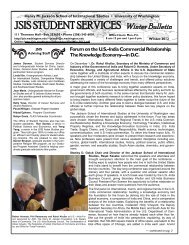Portrayal of Abortion in Russian Women's Literature - University of ...
Portrayal of Abortion in Russian Women's Literature - University of ...
Portrayal of Abortion in Russian Women's Literature - University of ...
Create successful ePaper yourself
Turn your PDF publications into a flip-book with our unique Google optimized e-Paper software.
<strong>Portrayal</strong> <strong>of</strong> <strong>Abortion</strong> <strong>in</strong> <strong>Russian</strong> Women’s <strong>Literature</strong><br />
by Jennifer Hark<strong>in</strong>s<br />
<strong>University</strong> <strong>of</strong> Wash<strong>in</strong>gton<br />
REECAS MA<br />
1
Dur<strong>in</strong>g the Soviet Union, Russia was said to have been experienc<strong>in</strong>g a demographic<br />
crisis. In the post WWII period, Russia suffered a large scale population decl<strong>in</strong>e due to a number<br />
<strong>of</strong> factors, primarily the high death rate caused by war, fam<strong>in</strong>e, and Stal<strong>in</strong>’s purges, coupled with<br />
a low birth rate and a high abortion rate. 1 <strong>Abortion</strong>, hav<strong>in</strong>g been illegal under Stal<strong>in</strong>’s rule was<br />
re-legalized <strong>in</strong> 1955 <strong>in</strong> the hope <strong>of</strong> curb<strong>in</strong>g the number <strong>of</strong> illegal abortions performed, and thus<br />
lower<strong>in</strong>g the number <strong>of</strong> maternal deaths due to these unsafe procedures. 2 <strong>Abortion</strong> has long been<br />
the most viable option for Soviet women to deal with unwanted pregnancies, s<strong>in</strong>ce other forms <strong>of</strong><br />
safe, reliable contraception was largely unavailable <strong>in</strong> the Soviet Union. Soviet women’s<br />
attitudes toward abortion are illustrated <strong>in</strong> women’s byt literature. Byt is def<strong>in</strong>ed as the<br />
monotonous rout<strong>in</strong>e <strong>of</strong> daily life, and is therefore gendered as female. I. Grekova says <strong>of</strong> byt:<br />
“For Soviet women, the notion <strong>of</strong> byt encompasses a great many th<strong>in</strong>gs, <strong>in</strong>clud<strong>in</strong>g stand<strong>in</strong>g <strong>in</strong><br />
l<strong>in</strong>es, lugg<strong>in</strong>g heavy bags <strong>of</strong> food, rid<strong>in</strong>g <strong>in</strong> overcrowded buses and subways, tak<strong>in</strong>g care <strong>of</strong><br />
children, cook<strong>in</strong>g, do<strong>in</strong>g the dishes, clean<strong>in</strong>g the house and do<strong>in</strong>g the laundry.” 3 The goal <strong>of</strong> this<br />
paper is to exam<strong>in</strong>e the portrayal <strong>of</strong> abortion <strong>in</strong> women’s writ<strong>in</strong>g. I will be look<strong>in</strong>g at selected<br />
works by Natal’ia Baranskaia, Mar<strong>in</strong>a Palei, Svetlana Vasilenko, Maria Arbatova, Liudmila<br />
Ulitskaia and Ir<strong>in</strong>a Velembovskaia.<br />
Among the authors listed, abortion is depicted <strong>in</strong> the follow<strong>in</strong>g three ways: 1) as<br />
women’s desperation to obta<strong>in</strong> abortions without regard to their health; 2) women’s resort to<br />
home remedies <strong>in</strong> order to <strong>in</strong>duce a miscarriage; and 3) the frequency at which women have<br />
abortions <strong>in</strong> their lifetime.<br />
1 For more <strong>in</strong>formation on Russia’s demographic crisis see Julie DaVanzo and Clifford Grammich, Dire<br />
Demographics: Population Trends <strong>in</strong> the <strong>Russian</strong> Federation, 2001, RAND, 23 Mar. 2006, 5 Jan. 2007,<br />
http://www.rand.org/pubs/monograph_reports/MR1273/.<br />
2 Andrej Popov and Henry David, “<strong>Russian</strong> Federation and USSR Successor States,” From <strong>Abortion</strong> to<br />
Contraception: A Resourse to Public Policies and Reproductive Behavior <strong>in</strong> Central and Eastern Europe from 1917<br />
to the Present, Ed. Henry David (Westport, CT: Greenwood Press, 1999), 237-239.<br />
3 I. Grekova, “Introduction,” Soviet Women Writ<strong>in</strong>g: Fifteen Short Stories (NY: Abbeville Press, 1990), 10.<br />
2
The fact that some women are fiercely determ<strong>in</strong>ed to stop a pregnancy at any cost is well<br />
illustrated <strong>in</strong> Mar<strong>in</strong>a Palei’s short story “The Bloody Women’s Ward” (“Otdelenie<br />
propashchikh,” 1988). Tak<strong>in</strong>g place <strong>in</strong> a maternity ward where abortions are also performed, the<br />
story enumerates the horrors <strong>of</strong> hospitals. In the open<strong>in</strong>g scene, a 50-year-old woman named<br />
Znobish<strong>in</strong>a comes <strong>in</strong>to the gynecologist’s <strong>of</strong>fice seek<strong>in</strong>g her second abortion <strong>in</strong> two months.<br />
Without ask<strong>in</strong>g what she came for, the bored and patroniz<strong>in</strong>g doctor already knows her story. In<br />
this case he is not will<strong>in</strong>g to give her an abortion, say<strong>in</strong>g that he will not risk a jail sentence by<br />
possibly perforat<strong>in</strong>g her uterus.<br />
The woman, as far as we can judge, has not altogether taken <strong>in</strong> the bit about the<br />
rupture, but has understood the bit about land<strong>in</strong>g beh<strong>in</strong>d bars, and, more specifically has<br />
gathered that there is no prospect whatsoever <strong>of</strong> another abortion….<br />
For all that [Razmetalsky] has not lost the ability to marvel. Even after twenty-two<br />
years <strong>in</strong> this practice he still marvels at the unassum<strong>in</strong>g way life shamelessly effects its<br />
birth even on scraped and stony ground. The woman can’t understand it either, but she<br />
does not marvel. Her only concern is to prevent it from happen<strong>in</strong>g. 4<br />
As Palei <strong>in</strong>s<strong>in</strong>uates, this peasant woman does not th<strong>in</strong>k about the ramifications <strong>of</strong> an abortion <strong>in</strong><br />
terms <strong>of</strong> her health, but th<strong>in</strong>ks only about the consequences <strong>of</strong> hav<strong>in</strong>g a child. In this passage,<br />
the doctor describes the woman’s uterus as be<strong>in</strong>g “scraped and stony ground” from the recent<br />
operation. There is an underly<strong>in</strong>g tone to the story that implies not only do women have very<br />
little choice or control over their own bodies, but that they also lack a basic understand<strong>in</strong>g <strong>of</strong><br />
their bodies.<br />
This sort <strong>of</strong> desperation <strong>of</strong> women <strong>of</strong>ten leads to illegal abortions, as is <strong>in</strong>tended here by<br />
Dr. Razmetalsky’s assistant Darya Petrovna. She comes to the woman’s rescue by promis<strong>in</strong>g to<br />
visit later <strong>in</strong> the week, imply<strong>in</strong>g that she will perform the illegal abortion herself. This passage<br />
suggests that this sort <strong>of</strong> under the table arrangement has been arranged more than once, and is<br />
someth<strong>in</strong>g that is silently condoned by the doctor himself.<br />
4 Mar<strong>in</strong>a Palei, “The Bloody Women’s Ward,” trans. Arch Tait, Glas: New <strong>Russian</strong> Writ<strong>in</strong>g no. 3 (1992): 75-76.<br />
3
“That’s all, Znobish<strong>in</strong>a,” says Darya Petrovna, part<strong>in</strong>g her lips just enough to let the<br />
words out. “I’ll be round to see your Z<strong>in</strong>a on Friday.”<br />
As she disappears through the door it still has not clicked with the woman that she has<br />
been saved. As usual Darya Petrovna will do what the doctor is afraid to do, and<br />
Razmetalsky, without for an <strong>in</strong>stant betray<strong>in</strong>g that he knows perfectly well what she is up<br />
to, f<strong>in</strong>ds this arrangement entirely satisfactory. 5<br />
It has been documented that illegal abortions are chosen over legal ones for a variety <strong>of</strong> reasons:<br />
1) if it poses a risk to the doctor (as it does <strong>in</strong> this case), there may be little choice; 2) women<br />
may be seek<strong>in</strong>g an abortion past the legal gestation period (i.e. up to 28 weeks); and 3) women<br />
want to preserve confidentiality, as records were public, and one <strong>of</strong>ten had to give a reason for<br />
hav<strong>in</strong>g a non-medical abortion.<br />
In revisit<strong>in</strong>g the open<strong>in</strong>g scene <strong>of</strong> “The Bloody Women’s Ward,” Dr. Razmetalsky<br />
crudely encourages Znobish<strong>in</strong>a, the peasant woman seek<strong>in</strong>g out yet another abortion, to take care<br />
<strong>of</strong> the matter herself:<br />
“Okay, sweetie pie. Go straight back home,” Razmetalsky f<strong>in</strong>ally drones, cont<strong>in</strong>u<strong>in</strong>g<br />
to wield the razor blade, “and do just as you please. Take qu<strong>in</strong><strong>in</strong>e if that’s what you want<br />
to do, or whatever it is you all poison yourselves with. Try lift<strong>in</strong>g your good husband <strong>of</strong>f<br />
the ground. I take it he’s a good size. Your husband is a good size, I suppose?” 6<br />
A similar scene is more graphically represented <strong>in</strong> Shamara (1990) by Svetlana<br />
Vasilenko. When Shamara asks a friend to help her get rid <strong>of</strong> an illegitimate child not belong<strong>in</strong>g<br />
to her husband, her friend responds: “I know <strong>of</strong> a sure method. My grandmother taught my<br />
mother, and my mother taught me…” 7 Later the scene unfolds with Shamara hold<strong>in</strong>g her<br />
stomach <strong>in</strong> pa<strong>in</strong>, and quickly expell<strong>in</strong>g the fetus <strong>in</strong>to a bathtub full <strong>of</strong> bloody water. She wraps it<br />
up <strong>in</strong>to a newspaper and gives it to her roommate to throw away. These two scenes illustrate the<br />
dramatic lengths women sometimes go to <strong>in</strong> their desperation to stop a pregnancy.<br />
5 Ibid, 76.<br />
6 Ibid, 74-75.<br />
7 Svetlana Vasilenko, “Shamara,” trans. Daria A. Kirjanov and Benjam<strong>in</strong> Sutcliffe, <strong>in</strong> Shamara and Other Stories,<br />
Ed. Helena Goscilo (Evanston, IL: Northwestern <strong>University</strong> Press, 2000), 52.<br />
4
Figure 1: <strong>Abortion</strong>s <strong>in</strong> the USSR <strong>in</strong> the post-Stal<strong>in</strong> period 8<br />
Number <strong>of</strong> <strong>Abortion</strong>s<br />
Millions<br />
9<br />
8<br />
7<br />
6<br />
5<br />
4<br />
3<br />
2<br />
1<br />
0<br />
1954 1959 1964 1969 1974 1979 1984 1989<br />
Years<br />
Total Legal <strong>Abortion</strong>s Spontaneous/crim<strong>in</strong>al abortions<br />
Figure 1 compares the number <strong>of</strong> “spontaneous 9 and crim<strong>in</strong>al abortions” to the number <strong>of</strong><br />
“complete legal abortions registered” <strong>in</strong> the USSR from 1954-1990. This data was primarily<br />
gathered through cl<strong>in</strong>ic studies and based on the data provided by medical establishments.<br />
Though the number <strong>of</strong> spontaneous/crim<strong>in</strong>al abortions are comparatively low <strong>in</strong> relation the legal<br />
abortions, it still represents a significant figure, averag<strong>in</strong>g around one million per year dur<strong>in</strong>g this<br />
time frame. One must also keep <strong>in</strong> m<strong>in</strong>d that illegal abortions were less <strong>of</strong>ten reported and<br />
represented <strong>in</strong> statistics, than legal abortions.<br />
8 Compiled by author us<strong>in</strong>g statistics provided by Alexander Avdeev, Ala<strong>in</strong> Blum and Ir<strong>in</strong>a Troitskaia,<br />
“L’avortement et la contraception en Russie et dans l’ex-URSS: histoire et present,” Dossiers et Recherches, no. 41<br />
(Paris : INED, October 1993), 46 cited <strong>in</strong> Christopher Williams, “<strong>Abortion</strong> and Women’s Health <strong>in</strong> Russia and the<br />
Soviet Successor States,” Women <strong>in</strong> Russia and Ukra<strong>in</strong>e, Ed. Rosal<strong>in</strong>d Marsh (NY: Cambridge <strong>University</strong> Press,<br />
1996), 137.<br />
9 Williams def<strong>in</strong>es spontaneous abortions, also referred to as miscarriages, as those caused by external factors like<br />
trauma or communicable diseases. It also <strong>in</strong>cludes <strong>in</strong>complete abortions. See pp. 131.<br />
5
Complications from abortion were very common and most <strong>of</strong>ten <strong>in</strong>cluded <strong>in</strong>flammation,<br />
hemorrhag<strong>in</strong>g, frigidity, sterility, fertility problems, and early menopause. Women also<br />
experienced troubles <strong>in</strong> hav<strong>in</strong>g subsequent children, result<strong>in</strong>g <strong>in</strong> miscarriages and pregnancy<br />
complications. Many <strong>of</strong> these problems were caused by the unhygienic conditions <strong>of</strong> the<br />
hospitals and cl<strong>in</strong>ic, the shortages <strong>of</strong> equipment, beds, and even staff members. 10<br />
We see evidence <strong>of</strong> this <strong>in</strong> women’s literature, especially <strong>in</strong> those that take place <strong>in</strong> a<br />
hospital ward like <strong>in</strong> Mar<strong>in</strong>a Palei’s “The Bloody Women’s Ward” and <strong>in</strong> Maria Arbatova’s “My<br />
Name is Woman”. In Palei’s short story there are a variety <strong>of</strong> problems—the water be<strong>in</strong>g shut<br />
<strong>of</strong>f, the doctor’s <strong>in</strong>competence at perform<strong>in</strong>g abortions, and the deliberate negligence <strong>of</strong> a<br />
deformed <strong>in</strong>fant <strong>in</strong> the hopes that it will die sooner. Whereas, <strong>in</strong> “My Name is Woman”, the<br />
women <strong>in</strong> l<strong>in</strong>e at the abortion cl<strong>in</strong>ic tell the protagonist she will be lucky if she gets a shot <strong>of</strong> a<br />
Novoca<strong>in</strong>, s<strong>in</strong>ce general anesthesia is rarely, if ever, given to patients.<br />
What appears more <strong>of</strong>ten <strong>in</strong> women’s byt literature is the fact that hav<strong>in</strong>g multiple<br />
abortions <strong>in</strong> one’s lifetime was a common and well-accepted fact <strong>of</strong> life for Soviet women. This<br />
facet <strong>of</strong> a woman’s life is shown <strong>in</strong> a number <strong>of</strong> stories: Ir<strong>in</strong>a Velembovskaia’s “Through Hard<br />
Times” (“V trudnuiu m<strong>in</strong>utu, 1965), Natal’ia Baranksaia’s A Week Like Any Other (Nedelia kak<br />
Nedelia, 1969), Maria Arbatova’s “My Name is Woman” (“Menia zovut zhenshch<strong>in</strong>a,” 1997),<br />
Liudmila Ulitskaia’s “The Orlov-Sokolovs” (“Orlovy-Sokolovy,” 2003), and as we have already<br />
seen <strong>in</strong> Mar<strong>in</strong>a Palei’s “The Bloody Women’s Ward.”<br />
“Through Hard Times” is about a woman who is taken to the hospital after receiv<strong>in</strong>g a<br />
severe blow to the head dur<strong>in</strong>g an attempt to stop a domestic argument between two strangers.<br />
While there, she develops a friendship and an <strong>in</strong>fatuation with one <strong>of</strong> the other male patients.<br />
Though the story is neither about birth nor abortion, but about love and relationships, there is a<br />
10 Ibid, 139.<br />
6
ief moment when an older couple discuss<strong>in</strong>g abortions catches the protagonist Pania’s<br />
attention:<br />
…Walk<strong>in</strong>g by, Pania heard the beautiful but cyanotic woman say as she firmly<br />
squeezed her husband’s hand <strong>in</strong> her own, “Vanka, take the money for the abortion to the<br />
receiv<strong>in</strong>g room. Or else the next time you come, your credit won’t be any good.”<br />
Pania stopped, struck by an unusual feel<strong>in</strong>g. “She hasn’t even gotten over this one,<br />
and she’s already plann<strong>in</strong>g for the next!” she thought with sad amazement. “She loves<br />
him!” 11<br />
That is all that is said or reflected about the decision to have an abortion <strong>in</strong> the entire story, but it<br />
does br<strong>in</strong>g to light a certa<strong>in</strong> type <strong>of</strong> mentality <strong>of</strong> Soviet women. Pania equates a woman’s<br />
will<strong>in</strong>gness to have multiple abortions, and to even go so far as to plan ahead for them, with love<br />
for her husband. This same <strong>of</strong>f-handed reference to abortion is also seen <strong>in</strong> Natal’ia<br />
Baranskaia’s novella A Week Like Any Other.<br />
In the follow<strong>in</strong>g scene <strong>of</strong> A Week Like Any Other, Dark Liusia 12 confesses to Ol’ga that<br />
the rumor about the plastiglass <strong>in</strong>vention be<strong>in</strong>g her own is true. She expla<strong>in</strong>s that the reason she<br />
gave her idea for the <strong>in</strong>vention to their boss was that she was pregnant at the time, and hav<strong>in</strong>g<br />
decided to keep the baby, she was prepared to leave her job and stay home to raise the child, as<br />
her husband had wished. However, unlike Ol’ga, who decided to keep her second child rather<br />
than abort it, Dark Liusia opts for an abortion at the very last m<strong>in</strong>ute.<br />
“And?”<br />
“And what?”<br />
“What happened to the child?”<br />
“What child? I cried <strong>of</strong>f at the last m<strong>in</strong>ute. I had an abortion. I kept it a secret from<br />
Suren, like I always do.”<br />
“How?”<br />
“I went on a research trip for five or six days…” 13<br />
11<br />
Ir<strong>in</strong>a Velembovskaia, “Through Hard Times,” Trans. Joseph Kiegel, <strong>in</strong> Balanc<strong>in</strong>g Acts: Contemporary stories by<br />
<strong>Russian</strong> women, ed. Helena Goscilo (Indianapolis, IN: Indiana <strong>University</strong> Press, 1989), 130.<br />
12<br />
The story has two characters both named Liusia. One is nicknamed Dark Liusia (Liusia chernoi), the other Blond<br />
Liusia (Liusia belen’koi).<br />
13<br />
Natalya Baranskaya, “A Week Like Any Other” <strong>in</strong> A Week Like Any Other: Novellas and Stories trans. Pieta<br />
Monks (Seattle: Seal Press, 1989) 47-48.<br />
7
It is implied through the dialogue that this was neither the first nor the last abortion that<br />
Dark Liusia has had. Another curious detail is her choice <strong>of</strong> words <strong>in</strong> keep<strong>in</strong>g the abortion a<br />
secret from her husband. In the orig<strong>in</strong>al <strong>Russian</strong> text, “I went on a research trip” (“edu v<br />
komandirovku”) 14 appears <strong>in</strong> quotation marks. Not only is it a lie, but <strong>in</strong> <strong>Russian</strong> it is <strong>of</strong>ten used<br />
as a euphemism for hav<strong>in</strong>g an abortion. Ironically, female employees were rarely ever sent on<br />
“research trips.” 15 In fact, because most doctors preferred methods like dilation and curettage<br />
over vacuum suction, most women were hospitalized for two or three days. 16 In an <strong>in</strong>terview<br />
conducted by Carola Hansson and Kar<strong>in</strong> Liden <strong>in</strong> 1978, one woman said, “It’s taken for granted<br />
that if a woman is absent from work for three days she’s hav<strong>in</strong>g an abortion.” 17<br />
The follow<strong>in</strong>g two short stories also have a brief, casual reference to young women<br />
hav<strong>in</strong>g several abortions <strong>in</strong>clud<strong>in</strong>g “My Name is Woman” which takes place dur<strong>in</strong>g the 1970s.<br />
In this scene the 18-year-old narrator, who is still <strong>in</strong> college, is taken to the gynecologist by her<br />
mother when she first f<strong>in</strong>ds out she is pregnant. In the cl<strong>in</strong>ic, she is not so much asked as what<br />
she wants to do, but <strong>in</strong>stead it is decided by both her mother and the doctor that she will get an<br />
abortion.<br />
“I’ll refer her for an abortion,” the doctor concluded.<br />
“An abortion, <strong>of</strong> course,” mother sang. “They’re much too young.”<br />
“You can say that aga<strong>in</strong>.” Barely r<strong>in</strong>s<strong>in</strong>g her hands, the woman immersed herself <strong>in</strong><br />
the epistolary act.<br />
“Graduate first, then get pregnant,” mother announced solemnly, as if someone had<br />
asked her what order to do th<strong>in</strong>gs <strong>in</strong>, and as if she had ever taken the trouble to enlighten<br />
me on the subject <strong>of</strong> contraception.<br />
“Their heads are too full <strong>of</strong> hav<strong>in</strong>g a good time to know what’s what,” the woman<br />
sighed.<br />
“It’s funny she didn’t try to persuade me to have it,” I said when we got outside.<br />
14<br />
Natal’ia Baranskaia, Nedelia kak nedelia, (Paris: Institut D’etudes Slaves, 1980) 27.<br />
15<br />
Thanks to Aida Lom<strong>in</strong>adze for po<strong>in</strong>t<strong>in</strong>g this out me.<br />
16<br />
Williams, 142.<br />
17<br />
Carola Hansson and Kar<strong>in</strong> Liden, Moscow Women, trans. Gerry Bothmer, George Blecher, and Lone Blecher<br />
(NY: Pantheon Books, 1983), 147.<br />
8
“She’s had fifteen abortions herself,” mother <strong>in</strong>formed me. 18<br />
Similarly, <strong>in</strong> Liudmila Ulitskaia’s story “The Orlov-Sokolovs,” mention <strong>of</strong> abortion is<br />
matter-<strong>of</strong>-factly referenced several times throughout the plot. Tanya, an <strong>in</strong>telligent, young<br />
woman at the top <strong>of</strong> her class has her first abortion dur<strong>in</strong>g her first year <strong>of</strong> college and cont<strong>in</strong>ued<br />
to have an “annual autumn abortion.” 19 Throughout the course <strong>of</strong> the story, Tanya had at least<br />
six abortions for the reason that she did not want to give up on her studies nor push back her<br />
potential career.<br />
…Tanya said <strong>in</strong> a desolate voice, “I th<strong>in</strong>k I’m up the creek aga<strong>in</strong>.”<br />
He turned on the light and lit a cigarette. She buried her face <strong>in</strong> her pillow to hide<br />
from the light.<br />
“Well, it’s time to go for it, I reckon. Have the baby this time. A girl, O.K.?”<br />
“Oh, I get it. You go for the postgraduate place and I go for a baby and chang<strong>in</strong>g<br />
diapers.”<br />
If she had been the type to cry, she would have cried then. As he realized.<br />
Tanya filled out the forms for the job at the <strong>in</strong>stitute, had an abortion, and took <strong>of</strong>f for<br />
the south. Andrey stayed beh<strong>in</strong>d to take the qualify<strong>in</strong>g exams for the postgraduate<br />
fellowship. Before she left, they went to the registry <strong>of</strong>fice and filled out an application<br />
to have their relationship <strong>of</strong>ficially recognized, which Andrey considered essential. 20<br />
Later <strong>in</strong> the story, when Tanya is pregnant aga<strong>in</strong>, this time with her new husband Vitya,<br />
she decides to go through with the pregnancy, partly out <strong>of</strong> vengeance to her ex-boyfriend<br />
Andrey. When she and Andrey meet up aga<strong>in</strong>, he tries to conv<strong>in</strong>ce her to leave her husband and<br />
come back to him.<br />
“Well, f<strong>in</strong>e. Let’s go around to his house right now and collect your th<strong>in</strong>gs so that<br />
there’s no misunderstand<strong>in</strong>g.” He made the suggestion so confidently that for a moment<br />
Tanya believed she would do it.<br />
“I’m pregnant, Andrey.”<br />
“That doesn’t matter. You’ll have to have another abortion. One last time.” Andrey<br />
shrugged.<br />
“No,” Tanya said gently. “I can’t do that anymore.” 21<br />
18 Maria Arbatova, “My Name is Woman,” trans. Kathleen Cook, Glas: New <strong>Russian</strong> Writ<strong>in</strong>g vol. 30 (2003): 46.<br />
19 Liudmila Ulitskaia, “The Orlov-Sokolovs,” trans. Arch Tait, The New Yorker 18 Apr. 2005.<br />
http://www.elkost.com/ludmila_ulitskaya/translations/the_new_yorker.html.<br />
20 Ibid.<br />
21 Ibid.<br />
9
I have cont<strong>in</strong>uously emphasized that the tone that comes across <strong>in</strong> byt literature when<br />
talk<strong>in</strong>g about abortion is very calm, nonchalant, and usually presents the <strong>in</strong>formation matter-<strong>of</strong>-<br />
factly. But I th<strong>in</strong>k that this particular passage really br<strong>in</strong>gs forth the mentality very clearly, <strong>of</strong><br />
not only women, but men too. Here, Andrey takes it for granted that abortions are very easily<br />
obta<strong>in</strong>ed and are culturally acceptable, but even goes further to assume that it is a simple<br />
procedure that women go through, when <strong>in</strong> fact, it is quite the opposite. Neither this story nor<br />
any <strong>of</strong> the others touch upon the emotional or psychological aspects <strong>of</strong> an abortion; but <strong>in</strong><br />
Tanya’s last l<strong>in</strong>e, it can be <strong>in</strong>terpreted that neither she nor her body can take the emotional or<br />
physical stra<strong>in</strong> <strong>of</strong> yet another abortion.<br />
In these excerpts we have seen some figures that to a Westerner are surpris<strong>in</strong>gly<br />
shock<strong>in</strong>g—six and even fifteen abortions. Is this an exaggeration or is this truly ord<strong>in</strong>ary for<br />
Soviet women? The frequency <strong>of</strong> abortions is revealed through a comb<strong>in</strong>ation <strong>of</strong> sources<br />
<strong>in</strong>clud<strong>in</strong>g studies conducted from 1958 to 1984, it has been estimated that up to two-thirds <strong>of</strong> the<br />
women between the ages <strong>of</strong> 25 and 34 had abortions. 22 In her book Soviet Women: Walk<strong>in</strong>g the<br />
Tightrope, Franc<strong>in</strong>e du Plessix Gray <strong>in</strong>terviews Olga Lipovskaya, the editor <strong>of</strong> the fem<strong>in</strong>ist<br />
magaz<strong>in</strong>e Zhenskoe Chtenie, who is described as follows: “Married three times, Olga has had<br />
two children and seven abortions. She estimates that she will have had about fourteen abortions<br />
‘before it’s all over;’ she considers fourteen to be the national average, and knows some women<br />
who have had twenty-five.” 23<br />
Figure 2 compares the number <strong>of</strong> live births to the number <strong>of</strong> legally <strong>in</strong>duced abortions<br />
from 1960 to 1997. Until the late 1980s, one can see that the two rates were practically mirror<br />
22 Williams, 136.<br />
23 Franc<strong>in</strong>e du Plessix Gray, Soviet Women: Walk<strong>in</strong>g the Tightrope (NY: Doubleday, 1990) 18-19.<br />
10
images <strong>of</strong> one another. When the birth rate was at its lowest po<strong>in</strong>t, abortion was at its highest.<br />
As births were steadily <strong>in</strong>creas<strong>in</strong>g throughout the ‘70s, abortions were slowly decreas<strong>in</strong>g.<br />
Baranskaia and Velembovskaia both published their stories <strong>in</strong> the mid to late ‘60s, when the<br />
abortion rate was at its highest. “The Orlov-Sokolovs” and “My Name is Woman,” though<br />
written <strong>in</strong> the late ‘90s, early 2000s, they took place dur<strong>in</strong>g the ‘60s and ‘70s respectively, while<br />
Palei wrote “The Bloody Women’s Ward” <strong>in</strong> the late ‘80s. Though the abortion rate had<br />
significantly dropped s<strong>in</strong>ce the ‘60s, it still rema<strong>in</strong>ed twice that <strong>of</strong> the birth rate until the ‘90s<br />
when the gap began to close.<br />
Figure 2: Birth and <strong>Abortion</strong> <strong>in</strong> Russia, 1960-1997 24<br />
6,000,000<br />
5,000,000<br />
4,000,000<br />
3,000,000<br />
2,000,000<br />
1,000,000<br />
Though the abortion rates are astound<strong>in</strong>gly high <strong>in</strong> comparison to the birth rates, one<br />
must keep <strong>in</strong> m<strong>in</strong>d that these statistics are usually based on those legally reported. The Soviet<br />
Union is known for not hav<strong>in</strong>g the most reliable and obta<strong>in</strong>able data, which is why numbers and<br />
24 Taken from Popov, 232-233.<br />
Number <strong>of</strong> Births and <strong>Abortion</strong>s <strong>in</strong> <strong>Russian</strong> Federation<br />
0<br />
1960 1965 1970 1975 1980 1985 1990 1995<br />
Legally Induced<br />
<strong>Abortion</strong>s<br />
Live Births<br />
Years<br />
11
figures <strong>of</strong>ten vary widely among scholars. But despite all this, one can easily assume that actual<br />
numbers were even higher once tak<strong>in</strong>g <strong>in</strong>to account all <strong>of</strong> the illegal, unreported, and self-<br />
<strong>in</strong>flicted abortions performed on or by Soviet women.<br />
Interest<strong>in</strong>gly enough, what is not portrayed <strong>in</strong> the literature is any sort <strong>of</strong> moral or<br />
religious debate surround<strong>in</strong>g abortion. Anti-abortion campaigns did appear <strong>in</strong> the 1970s and<br />
‘80s. One tactic was to scare women with horror stories <strong>of</strong> abortions gone terribly wrong, and<br />
the other approach was to appeal to women’s moral conscious. The campaign failed for many<br />
reasons, one <strong>of</strong> which was the fact that it did take on a moral tone. Other factors <strong>in</strong>cluded the<br />
fact that women’s op<strong>in</strong>ions were not heard, their motives for hav<strong>in</strong>g abortions not addressed, and<br />
most importantly, no other alternatives to abortion were provided. 25<br />
Women’s byt literature gives us more <strong>in</strong>formation about the reality surround<strong>in</strong>g abortion<br />
and contraception than do <strong>of</strong>ficial statistics. We see at an emotional level how women relate to<br />
unwanted pregnancies: desperately, fearlessly, yet frequently, even f<strong>in</strong>d<strong>in</strong>g the means to do so at<br />
home. Many women <strong>of</strong>ten had resort to abortions s<strong>in</strong>ce contraception was not always a viable<br />
option. The commonality <strong>of</strong> Soviet women hav<strong>in</strong>g multiple abortions—legal, illegal, and self-<br />
<strong>in</strong>duced—is corroborated with various <strong>in</strong>terviews taken dur<strong>in</strong>g the same timeframe and also<br />
reflected <strong>in</strong> the high abortion and low birth rates.<br />
25 Williams, 146-147.<br />
12
Works Cited<br />
Arbatova, Maria. “My Name Is Woman.” Translated by Kathleen Cook. Glas New <strong>Russian</strong><br />
Writ<strong>in</strong>g. v 30. 44-65.<br />
Baranskaya, Natalya. “A Week Like Any Other” <strong>in</strong> A Week Like Any Other: Novellas and<br />
Stories Trans. Pieta Monks. Seattle: Seal Press, 1989. 1-62.<br />
Baranskaia, Natal’ia. Nedelia kak nedelia. Paris: Institut D’etudes Slaves, 1980.<br />
DaVanzo, Julie and Clifford Grammich. Dire Demographics: Population Trends <strong>in</strong> the <strong>Russian</strong><br />
Federation. 2001. RAND. 23 Mar. 2006. 5 Jan. 2007<br />
http://www.rand.org/pubs/monograph_reports/MR1273/.<br />
Gray, Franc<strong>in</strong>e du Plessix. Soviet Women: Walk<strong>in</strong>g the Tightrope. NY: Doubleday, 1990.<br />
Grekova, I. “Introduction.” Soviet Women Writ<strong>in</strong>g: Fifteen Short Stories. NY: Abbeville Press,<br />
1990. 9-14.<br />
Hansson, Carola and Kar<strong>in</strong> Liden. Moscow Women. Trans. Gerry Bothmer, George Blecher, and<br />
Lone Blecher. NY: Pantheon Books, 1983.<br />
Palei, Mar<strong>in</strong>a. “The Bloody Women’s Ward.” Trans. Arch Tait. Glas: New <strong>Russian</strong> Writ<strong>in</strong>g no. 3<br />
(1992): 74-93.<br />
Popov, Andrej and Henry David, “<strong>Russian</strong> Federation and USSR Successor States.” From<br />
<strong>Abortion</strong> to Contraception: A Resource to Public Policies and Reproductive Behavior <strong>in</strong><br />
Central and Eastern Europe from 1917 to the Present. Ed. Henry David. Westport, CT:<br />
Greenwood Press, 1999. 223-278.<br />
Ulitskaia, Liudmila “The Orlov-Sokolovs.” Trans. Arch Tait. The New Yorker 18 Apr. 2005.<br />
http://www.elkost.com/ludmila_ulitskaya/translations/the_new_yorker.html.<br />
Vasilenko, Svetlana. “Shamara.” Trans. Daria A. Kirjanov and Benjam<strong>in</strong> Sutcliffe <strong>in</strong> Shamara<br />
and Other Stories. Ed. Helena Goscilo (Evanston, IL: Northwestern <strong>University</strong> Press,<br />
2000), 3-58.<br />
Velembovskaia, Ir<strong>in</strong>a. “Through Hard Times.” Trans. Joseph Kiegel, <strong>in</strong> Balanc<strong>in</strong>g Acts:<br />
Contemporary stories by <strong>Russian</strong> women. Ed. Helena Goscilo. Indianapolis, IN: Indiana<br />
<strong>University</strong> Press, 1989. 126-142.<br />
Williams, Christopher. “<strong>Abortion</strong> and Women’s Health <strong>in</strong> Russia and the Soviet Successor<br />
States.” Women <strong>in</strong> Russia and Ukra<strong>in</strong>e. Edited by Rosal<strong>in</strong>d Marsh. NY: Cambridge<br />
<strong>University</strong> Press, 1996. 131-155.<br />
13

















